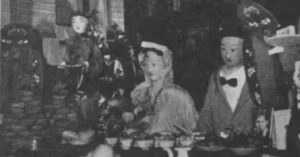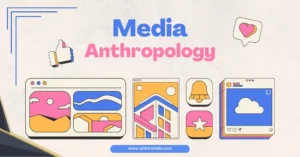AI Answer Evaluation Platform Live Now. Try Free Answer Evaluation Now
Visual Anthropology
Anthropologist Karl Heider describes ‘visual anthropology’ as the use of visual material in conveying anthropological research[1]. The source of media can either be photo-video cameras or other forms of visual representation like diagrams, sketches and portraits. Visual anthropology is the scholarly use of technology in visually documenting and reconstructing the ‘sensory experiences of fieldwork’[2]. Anthropology is dominated by field based methods and participant observations. In visual anthropology, theoretical angles are supplemented by filmed footage and photographs to give the viewer an actual immersive encounter with socio-cultural settings.

Anthropology is Inherently ‘Visual’
Karl Heider expresses that it is difficult to imagine a non-visual anthropology.[1] The use of multimedia like film, photography, spoken word has been around since the very beginning of the discipline. Visual methods were central to early field-based expeditions as with A.C. Haddon’s work in 1898 on the Torres Straits Islands, where he incorporated highly scientific recording techniques and color photographs.[3]
In the late-nineteenth century Franz Boas, the father of anthropology, was also enthusiastic about using photography in capturing the ceremonial and cultural aspects of the Kwakiutl Indians. However, he rejected such methods for being too superficial and lacking the interpretative command that language brought[4]. Nevertheless, his student Margaret Mead made extensive use of photography in her work on Bali in the 1940s where over 25,000 photographs were captured. Mead then went on to pioneer a method of inferring cultural patterns by observing photographs. [5]
Mead and her peers argued that anthropology after all is an inherently visual pursuit driven by observation and data collection conducted in a participatory mode.
However, when social and cultural anthropology were established in Britain and the U.S. respectively, the appeal for rejecting visual and sensory methods increased. [6] This was in favor of a more scientific, theoretical and objective approach which subsequent scholars favored.
Rejection of Visual Anthropology
The early criticism of visual media in anthropology harkens back to the Eurocentric practice of colonial photography which captured tribes and primitive societies as ‘the others’ or as exotic specimens. This however, was hardly a threat to the visual sub-discipline. The sensory, visual and applied forms of anthropology were frowned upon in the 1950s. This was in-part due to the employment of scholars in colonies as applied anthropologists during the social unrest of the interwar period and colonial expansion into third world countries [7]
The subsequent social anthropology of Britain seeked to make a distinction between pure (academic) and applied forms of anthropology by promoting cultural relativism and ethical scientific research.
In light of these events visual anthropology remained a contested domain even before its name was coined in 1960 by Margaret Mead.
Rebirth of Visual Anthropology
In 1970 The Society for the Anthropology of Visual Communication was established in the U.S. which attested a scholarly acceptance into mainstream anthropology. Works like Visual Anthropology: Photography as a Research Method by John Collier became a leading textbook in the domain which was fast emerging as a truly informed undertaking in ethnography and research. Robert Gardner, David and Judith MacDougall, Tim Asch and John Marshall were forerunners in visual anthropology, working with African tribes, Native American cultures and Australian aborigines.
Different from Ethnographic Film?
Visual anthropology gained considerable reputation with the advent of compact cameras and lightweight recording equipment following the 1980s. Ethnographic film is the mainstream form of visual anthropology, which saw many anthropologists like Jean Rouch and MacDougall adopting commercial filmmaking techniques. This served high-production demand and remains one of the longstanding subjects of debate.
Karl Heider describes the two domains as bearing fuzzy distinctions and intersecting in nature.[1] Works like Nǃai, the Story of a ǃKung Woman (1980) by John Marshall and Rivers of Sand (1975) by Robert Gardner are crucial in throwing light on the various cultural features of remote communities and etching them into the consciousness of the mainstream.
Ethnographic film is criticized for being unscholarly and bearing unethical means of documentation. Additionally, due to its slick and polished production there is danger of footage manipulation to serve the narrative that a project upholds.
Anthropologist Sol Worth expresses his concern about the same by saying –
“Film footage, unorganized but uncut, is considered the most scientific and therefore the truest because it captures ”real behavior” presumably untouched by human eye or brain – a pure record.” – from Worth, S. (1980). [5]
Current Trends in Visual Anthropology
The most recent facet of the sub-discipline is the rising shift from visual to ‘multimodal’ anthropology.[8] This trend is to embody the nature of media in recent times including the use of smartphones, virtual reality, podcasts, theater and video games. It is true that anthropologists today make considerable use of technology even in strictly theoretical studies. But now, we see the growing impetus of the rapidity of technological change in contemporary research.
Scope of Visual Anthropology
The discipline demands training in all pursuits of visual production like videography, sound recording, video editing etc. As a result, current masters and PhD programs include these modules along with field-based and theoretical research methods.
Most leading anthropology colleges offer these courses including Universities of Harvard, Oxford, London and Manchester.
Conclusion
It is apparent that visual anthropology has survived the various academic and epistemological debates in the field of Anthropology. Additionally, the history of the sub-field celebrates Dr. Margaret Mead as a leading scholar in the domain from its conception to its rising popularity in the 1970s. The various technological changes continue to shape the nature and scope of the discipline. Visual anthropology has continually embodied the researcher as well as the subject’s sensory and auditory experience in producing solid tangible research works. It is hence clear that while anthropology has been unarguably ‘visual’, Visual anthropology has never been fully visual.[6]
FAQs about Visual Anthropology
See Also
References
[1] https://www.youtube.com/watch?v=9UAplwa4fYk&ab_channel=CentralWashingtonUniversity (Interview footage)
[2] Cook, S. (2004) ‘Between the Book and the Cinema: late Victorian new media’ Visual Studies 19(1): 60–71.
[3] Griffiths, A. (2002) Wondrous Difference: Cinema, Anthropology and Turn-of-the-century Visual Culture, New York: Columbia University Press.
[4] Jacknis, I. (1984) ‘Franz Boas and Photography’, Studies in Visual Communication 10(1): 2–60.
[5] Worth, S. (1980). Margaret Mead and the Shift from “Visual Anthropology” to the “Anthropology of Visual Communication”. 6 (1), 15-22.
[6] Pink, S. (2006). The future of visual anthropology : engaging the senses. Routledge.
[7] Kuper, A. (1996) Anthropology and Anthropologists, London: Routledge.
[8] Collins, Samuel Gerald; Durington, Matthew; Gill, Harjant (2017-01-12). “Multimodality: An Invitation”. American Anthropologist. 119 (1): 142–146. doi:10.1111/aman.12826. hdl:11603/11766. ISSN 0002-7294.




